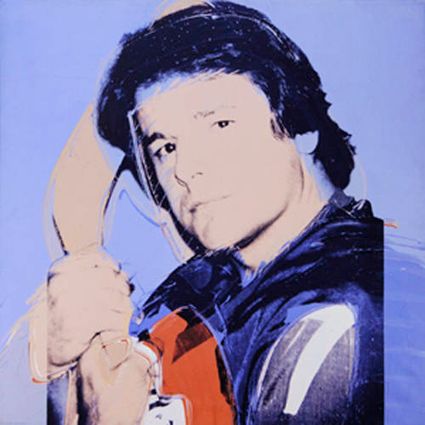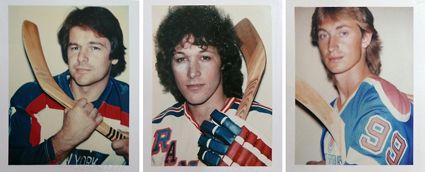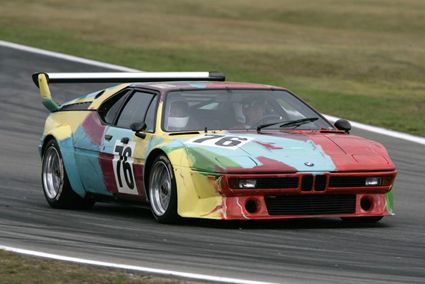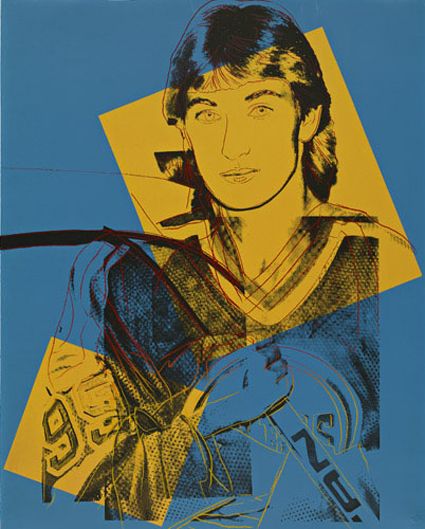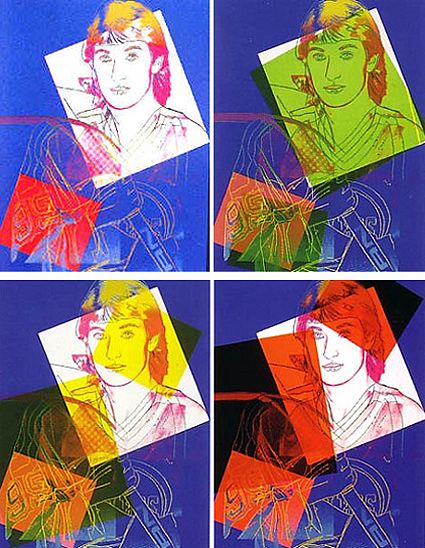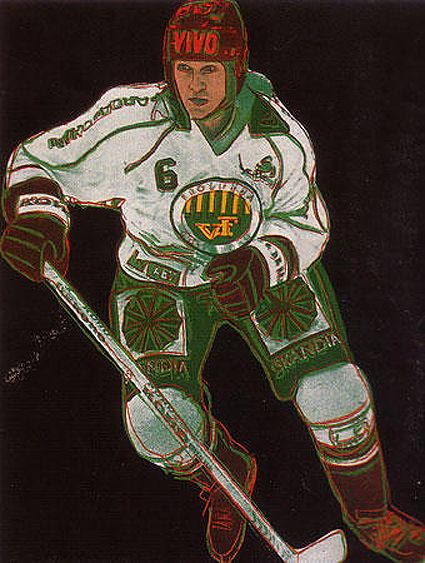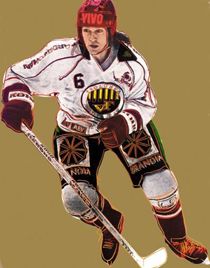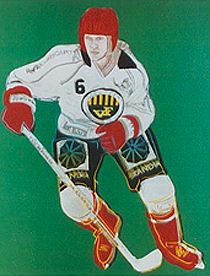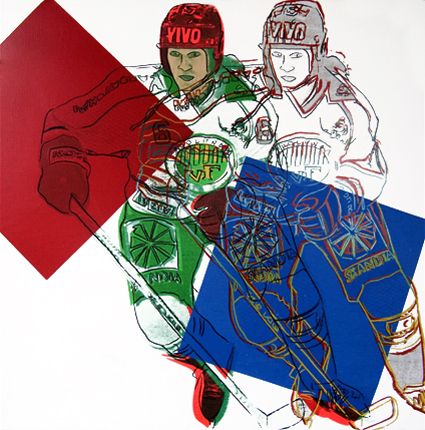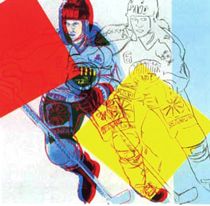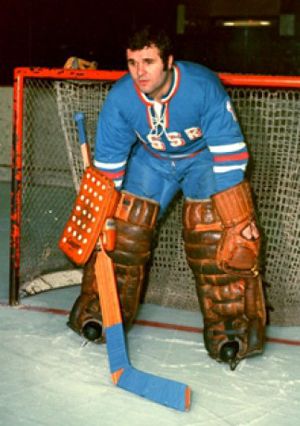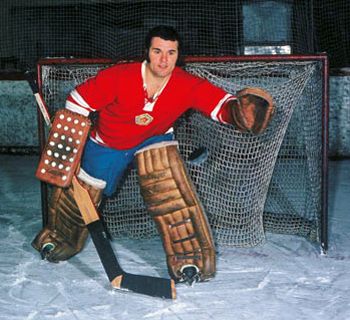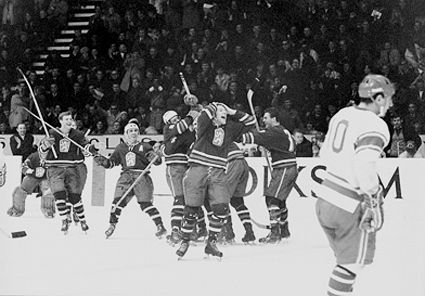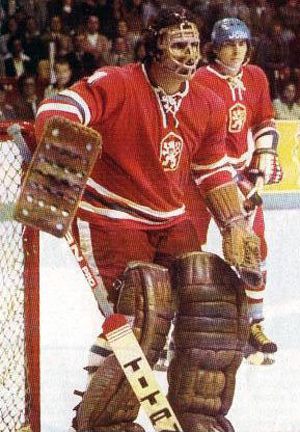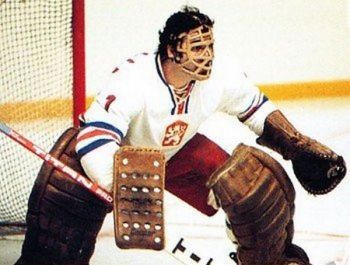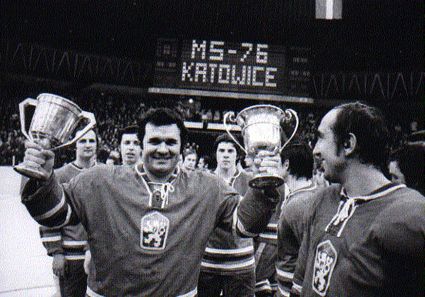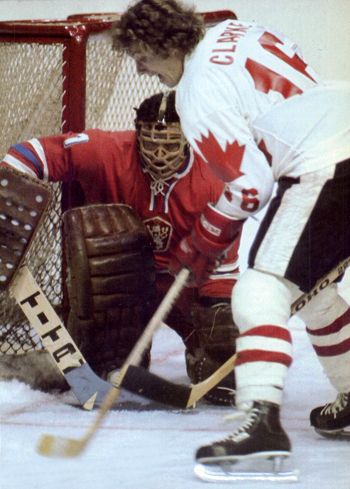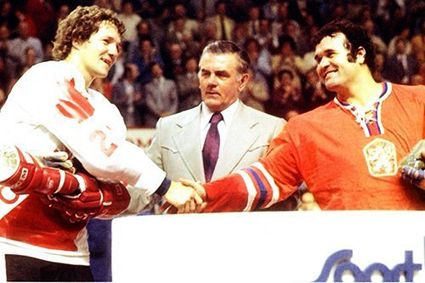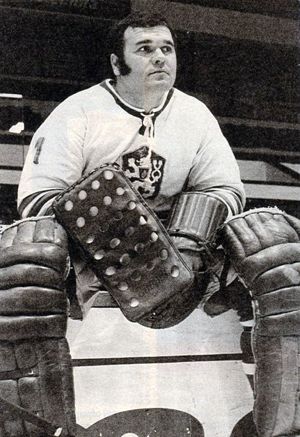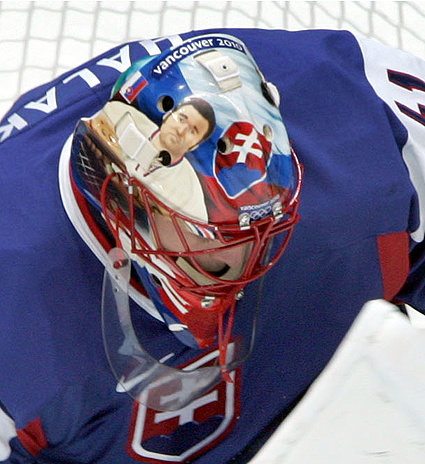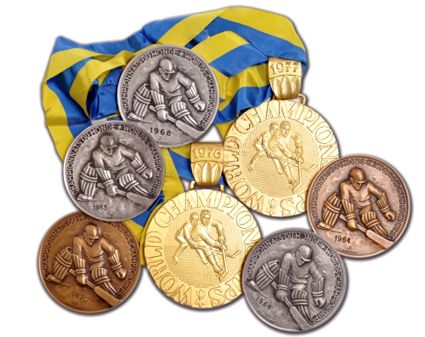Thursday, August 6, 2015
The Hockey Art of Andy Warhol
Born on this date in 1928, Andy Warhol is not the first name that comes to mind when thinking of sports related art, as he is best known for his portraits, such as those of celebrities like Marilyn Monroe, Jackie Kennedy and Liz Taylor, and political icons, such as Mao Tse-Tung, Vladimir Lenin and Che Guevara.
In addition to his paintings, Warhol was a filmmaker and also created works in many other media. He also introduced the phrase "15 minutes of fame" to the English lexicon.
From a monetary standpoint, Warhol ranks among a very elite group of artists, Jackson Pollock, Willem de Kooning, Gustav Klimt, Vincent van Gogh, Pierre-Auguste Renoir, Pablo Picasso and Warhol, who have had an individual piece sell for $100 million.
Warhol did create a number of sports related pieces throughout his career though, almost exclusivley on a commission basis. His first photo-silkscreened painting was a baseball scene, done in back in 1962. It was the first and last time he chose sports as a subject on his own.
Warhol's first real entry into the world of sports related art, and his first hockey piece, was when he was commissioned fifteen years later to create a series of works for businessman Richard Weisman in 1977, known as the "Athlete Series", which featured Jack Nicklaus, Kareem Abdul-Jabbar, Willie Shoemaker, Dorothy Hamill, Chris Evert, Pele, Tom Seaver, O. J. Simpson, Muhammad Ali and hockey player Rod Gilbert.
Rod Gilbert by Andy Warhol
On September 2, 2009 the ten 40" square canvases were stolen from the Los Angeles home of Weisman, along with a portrait of Weisman done by Warhol. Anyone with information about the theft can call the Los Angeles Police Department at 231-485-2524.
The polaroid photos Warhol took for the Athlete Series have been displayed on their own, and include additional portraits of hockey players Ron Dugay and Wayne Gretzky taken at a later time than those used to produce the Athlete Series.
Polaroid photos taken by Warhol as the basis for future paintings
In 1978, Warhol revisited one of the subjects of the Athlete Series, Muhammad Ali. Four separate pieces were created at that time.
One of Warhol's better known works related to the world of sports was the occasion when he was commissioned by BMW to paint one of their M1 race cars as the fourth in a series of BMW Art Cars, which would later compete at the famed 24 Hours of Le Mans.
"I tried to portray speed pictorially. If a car is moving really quickly, all the lines and colors are blurred.", Warhol explained. Of note, the car finished second in it's class and sixth overall out of 55 starters in 1979, the only time it ever raced.
His next sports themed work was that of a speedskater, which was his contribution to "The Official Art Portfolio of the XIV Olympic Winter Games" in Sarajevo, Yugoslavia in 1983. He was one of 17 artists to contribute to the project.
In 1984, Warhol produced two separate pieces commissioned by long-time Canadian art gallery owner Frans Wynans featuring Gretzky. One was entitled "Wayne Gretzky 99" and produced in a limited edition of 300.
As was often the case with Warhol's silkscreened prints, a variety of color versions can be found of this work. The silkscreen prints were originally sold for $1,500 and now require between $15,000-$20,000 to obtain.
The other piece was a series of six portraits of Gretzky holding a hockey stick. The portraits originally sold for $35,000 and now sell for more than ten times that much at $390,000.
Again, there were various versions of "Wayne Gretzky" produced despite the much more limited numbers produced.
As a fundraiser for the Cincinnati Art Museum, Warhol created a poster featuring Cincinnati baseball icon Pete Rose, done in the style of a baseball card in 1985. Also that same year, he created a polo player for the cover of the 10th anniversary of Polo magazine.
One final hockey themed work of Warhol's was "Frölunda Hockey Player" in which he depicts a skater from the Swedish club Frölunda HC, Christer Kellgren, which was created in 1986. The piece was a commissioned project by the Art Now Gallery in Göteborg, Sweden, which is home to the Frölunda Indians.
Typical of the works of Warhol, several distinct variations of this piece were made in widely differing colors.
There was also another group of the Frolunda Hockey Player made which featured two images of the player done in several variations.
Warhol died the following year at the age of 58 from a sudden cardiac arrhythmia following a routine surgery.
Today's video section will be unlike any other we've ever had, and it begins with Andy Warhol Eats a Hamburger.
Next, Andy appears in a commercial for Braniff Airlines with heavyweight boxing champion Sonny Liston. There's no way that's Andy's voice either.
Finally, "Andy Warhol" by David Bowie.
For more on Warhol, here is a link to the PBS American Masters series on Andy Warhol in 12 parts, which runs roughly two hours and contains absolutely no hockey whatsoever.
Labels:
Warhol Andy
Sunday, August 2, 2015
1976 Czechoslovakia Vladimír Dzurilla Jersey
While he did not become known to hockey fans in North America until his performance in the 1976 Canada Cup, Vladimir Dzurilla's playing career began many years earlier when he first took to manning the net for HC Slovan Bratislava in his native Czechoslovakia for the 1960-61 season where Slovan finished as runners-up in the Czechoslovak Extraliga.
Two seasons later Dzurilla made his international debut for the Czechoslovakia National Team at the 1963 World Championships where he played in four of their seven games to earn his first medal, a bronze.
In the following season of 1963-64, Dzurilla continued his career with Slovan Bratislava, finishing second for the third time in his four seasons. He then made his Olympic debut at the 1964 Games in Innsbruck, Austria, playing in two games and earning his first Olympic medal, again a bronze.
Another runner-up finish with Bratislava was followed by another appearance at the 1965 World Championships, where Dzurilla played in five games with a 1.26 goals against average and a silver medal behind the dominant Soviet Union. Dzurilla was named to the tournament All-Star Team and was recognized as the tournament's Best Goaltender.
1965-66 was another season with Slovan Bratislava, where the club came home third for the second time in his career, the other being 1962-63. He then earned a second silver medal at the 1966 World Championships in Ljubljana, Yugoslavia.
Injury curtailed his 1966-67 season, with just 9 games played in the Czechoslovakia Extraliga, but Dzurilla bounced back in fine style with a new career best goals against average of 2.47 in 1967-68 which earned him a second trip to the Olympic Games. He was limited to just one game in Grenoble, France, but the team took second place to earn the silver medal.
The 1968-69 season saw another season with Slovan and a goals against under 3.00 at 2.91 and another third place in the league. The 1969 World Championships were a politically charged affair following the Soviet Union's invasion of Czechoslovakia in August of 1968 following the Prague Spring, a period of liberalization and greater freedoms in Czechoslovakia under Alexander Dubček.
The 1969 World Championships were originally scheduled to be held in Prauge, but were relocated to Stockholm, Sweden due to the ongoing invasion in Czechoslovakia.
Following the 1976-77 regular season, Dzurilla would close out his international career in fine style, playing seven of the Czechs ten games with a 2.70 goals against average. The Czechs would defeat the Soviet Union and Sweden in the Final Round to defend their championship from the previous year thanks to a 7-2-1 record, one point better than Sweden and the Soviet Union at 7-3 thanks to their 3-3 tie against Canada earlier in the competition.
Dzurilla would play one final season in Czechoslovakia for Brno, which included traveling to North America to backstop the Czechs during their games against teams from the World Hockey Association which unusually counted in the WHA regular season standings.
From there, Dzurilla would spend the final four seasons of his 22 year career in Germany, first for Augsburger EV (Augsburger Panthers) in 1978-79 and then three seasons with SC Riessersee, which saw him named Germany's Best Goaltender in both 1980 and 1981.
Today's featured jersey is a 1976 Czechoslovakia Vladimír Dzurilla jersey as worn in the 1976 Canada Cup when Dzurilla shutout Canada in Montreal in a dramatic 1-0 win, considered one of hockey's greatest games.
This particular jersey wound up in the possession of Canada's goaltender Vachon when the teams traded jerseys after the contest in the European tradition.
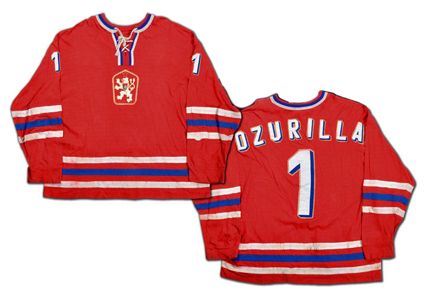
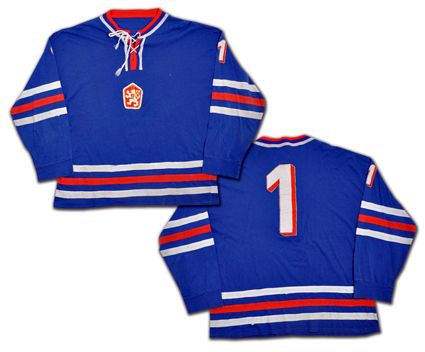
Here is a special treat, footage of Czechoslovakia beating the Soviet Union at the 1969 World Championships, showing footage from the game as well as the heroes welcome they received when they returned home.
Two seasons later Dzurilla made his international debut for the Czechoslovakia National Team at the 1963 World Championships where he played in four of their seven games to earn his first medal, a bronze.
In the following season of 1963-64, Dzurilla continued his career with Slovan Bratislava, finishing second for the third time in his four seasons. He then made his Olympic debut at the 1964 Games in Innsbruck, Austria, playing in two games and earning his first Olympic medal, again a bronze.
Another runner-up finish with Bratislava was followed by another appearance at the 1965 World Championships, where Dzurilla played in five games with a 1.26 goals against average and a silver medal behind the dominant Soviet Union. Dzurilla was named to the tournament All-Star Team and was recognized as the tournament's Best Goaltender.
1965-66 was another season with Slovan Bratislava, where the club came home third for the second time in his career, the other being 1962-63. He then earned a second silver medal at the 1966 World Championships in Ljubljana, Yugoslavia.
Injury curtailed his 1966-67 season, with just 9 games played in the Czechoslovakia Extraliga, but Dzurilla bounced back in fine style with a new career best goals against average of 2.47 in 1967-68 which earned him a second trip to the Olympic Games. He was limited to just one game in Grenoble, France, but the team took second place to earn the silver medal.
The 1968-69 season saw another season with Slovan and a goals against under 3.00 at 2.91 and another third place in the league. The 1969 World Championships were a politically charged affair following the Soviet Union's invasion of Czechoslovakia in August of 1968 following the Prague Spring, a period of liberalization and greater freedoms in Czechoslovakia under Alexander Dubček.
Soviet tanks invade Prague
The 1969 World Championships were originally scheduled to be held in Prauge, but were relocated to Stockholm, Sweden due to the ongoing invasion in Czechoslovakia.
began on March 15th, when the Czechs defeated Canada by a resounding 6-1 score. Sweden beat Finland 6-3 and the Soviet Union destroyed the United States with a 17-2 pummeling also on day one which would prove vital later in the tourament. Entering the tournament the Soviet Union had won the last six World Championships as well as the last three out of four Olympic Games.
On March 21st, the Czechs and Soviets met in day six of the tournament with the Soviets at 4-0 with a 34-6 edge in goals scored up to that point, while the Czechoslovakians were 3-1 following a 2-0 loss to Sweden.
To the Soviet team this was just another hockey game, but not to the Czechs. With 70,000 Red Army soldiers still occupying their country, it was about much more than just hockey.
“We said to ourselves, even if we have to die on the ice, we have to beat them,” said team captain Jozef Golonka many years later. “We received hundreds of telegrams from fans back home when we arrived in Stockholm. Almost all of them said: ‘Beat the Soviets. You don’t have to beat anyone else. Just beat the Soviets.’”
Following a scoreless first period, defenseman Jan Suchý scored his fifth goal of the competition at the 13 minute mark of period two to put the Czechs on top. Josef Černý added a second goal at the seven minute mark of the third period while Dzurilla held the Soviets at bay for a 2-0 shutout, sending thousands of Czechoslovakians into the streets back in Prague in celebration.
The Czechs then wrapped up three more wins until they were matched up against the Soviets for the second time, as the tournament format was for each of the six teams to face the other five two times each. The Soviet Union meanwhile marched through their three subsequent games as expected, setting up the rematch with both teams now at 7-1.
Jiří Holík opened the scoring at 15 minutes to put the Czechs ahead 1-0 after one. Vaclav Nedomanský gave the Czechs a 2-0 lead in the first minute of the second, but Valeri Kharlamov responded for the Soviet Union two minutes later and Anatoli Firsov tied the game at the 13 minute mark.
Josef Horešovský delighted the Czech fans with a go-ahead goal at the nine minute mark of the third period before Jaroslav Holík sent them into rapture with another Czech score just two minutes later. Alexander Ragulin got one back for the Soviets with less than two minutes to play, but it was not enough as Czechoslovakia held on for a 4-3 win, becoming the first team to ever defeat the Soviet Union twice in a single IIHF tournament.
Once again, a reported half a million Czechoslovakians took to the streets across the country in what was first a celebration of their hockey team's victory, but, particularly in Prague, evolved into a protest against the Soviet military which had continued their occupation of Czechoslovakia since the previous August.
From Time Magazine April 11, 1969:
Overcome by a vicarious sense of triumph, a huge and excited crowd swarmed into Prague’s Wenceslas Square. One happy hockey fan carried a poster that read BREZHNEV 3, DUBČEK 4. The crowd chanted, “We’ve beaten you this time!” Someone shouted, “The Russian coach will go to Siberia!”
Those particular protests turned violent when not only Soviet military units were attacked and their vehicles burned, but the offices of the Soviet airline Aeroflot were ransacked in what became known at the Czechoslovak Hockey Riots.
The uprising was suppressed by the Czech military, which was now under control of hardliners from the Communist Party, and the events were used as a pretext to oust the remaining leaders of the Prague Spring from power, Dubček in particular.
Heading into the final two days of the tournament, Czechoslovakia led with an 8-1 record, while the Soviet Union, thanks to their two losses to the Czechs were 7-2 and Sweden was 6-2 after a pair of losses to the Soviet Union. Sweden climbed into a tie with the Soviets thanks to taking their turn pounding the winless United States 10-4.
On March 30th, the Czechs let the gold medal slip from their grasp following a 1-0 loss to Sweden while the Soviet Union made it a three way tie atop the standings at 8-2 thanks to their 4-2 win over Canada. Since the Czechs beat the Soviets twice who beat the Swedes twice who beat the Czechs twice, the medal placings were decided by goal differential, giving the Soviet Union the gold with a +36, the Swedes silver at +26 and the Czechs bronze at +20, which mattered little to the fans back at home following their joy at beating the country of their occupying forces not once, but twice. ”You sent us tanks, we send you goals” was the celebratory cry.
For the 1969-70 season, Slovan Bratislava earned yet another second place finish in the Extraliga behind Dzurilla's career best 2.15 goals against average in 34 games played, which was his career high at the time. Later that season Dzurilla would earn his third World Championship bronze medal.
The 1970-71 season would be a limited one for Dzurilla, seeing action in just 19 games and would not compete in the World Championships for only the second time in his career, the other being 1967.
He would make up for it with a busy 1971-72 season, as he would play 29 games of Bratislava's regular season, capped off with Slovan's second place finish yet again, the fifth of his 12 years with the club.
Internationally, Dzurilla competed in his second Olympic Games in Sapporo, Japan where he earned his third Olympic medal and second bronze.
1972 also marked the first time that the World Championships were played separately in the same year as the Olympics, and were held in Prague for the first time since 1959, thanks to their relocation three years earlier due to the Soviet invasion.
The Czechs opened the tournament in dominating fashion, defeating Switzerland 19-1 and then scored wins against Sweden (4-1) and West Germany (8-1) before crafting a 3-3 tie against the Soviets. They then reeled off wins against Finland (5-3), Switzerland (12-2), Sweden (2-0), West Germany (8-1), the Soviet Union (3-2) and finally Finland (8-2) to not only earn the first gold medal of Dzurilla's career, but just the third the history of Czechoslovakia and first since 1949. There was also a certain level of satisfaction in being the ones to end the ten consecutive World Championship and Olympic gold medal streak of the Soviets which dated back to 1963.
Dzurilla would play his 13th and final season for Slovan Bratislava in 1972-73, which included Slovan would traveling to Switzerland, where Dzurilla and the team would win the annual Spengler Cup tournament.
He would then move to HC Kometa Brno for the next five seasons, from 1973-74 through 1977-78. During that time period, Dzurilla would return to the World Championships for the first time since 1972's gold medal winning team. And it was a successful return as the Czechs again captured the gold in Katowice, Poland with a perfect 7-0 record for the second gold medal of Dzurilla's career.
Later that year he gained his first real exposure to North Americans when he competed in the 1976 Canada Cup tournament with a strong performance, posting a 2.36 goals against playing in all five games for the Czechs, which saw them open with a 5-3 win over the Soviet Union followed by an 8-0 pounding of Finland. A 4-4 tie with a scrappy United States was followed by a stunning 1-0 shutout over Canada in front of a sold out Forum in Montreal and millions watching on television, which cemented Dzurilla's legacy as a stellar international goaltender in what many immediately called one of the greatest games of all time.
While the Czechs lost to Sweden 2-1 in their final round robin game, they still advanced to the best-of-two final against Canada, where the Canadians chased him from the nets with four goals in the first period of Game 1. After Jiří Holeček let in two goals in the first 3:09, Dzurilla came in and held the Canadians to one power play goal as the Czechs stormed back to take the lead 4-3 with four minutes remaining only to see Canada tie the game with just 2:12 left in regulation when Dzurilla sent a clearing attempt right to Canada's Bill Barber, who buried the puck into the unattended goal.
The game would then go to overtime with both Dzurilla and Rogie Vachon making great saves at either end before Canada would take the title with a goal 11:33 into overtime with Dzurilla recording 29 saves in over 68 minutes of relief.
For the 1969-70 season, Slovan Bratislava earned yet another second place finish in the Extraliga behind Dzurilla's career best 2.15 goals against average in 34 games played, which was his career high at the time. Later that season Dzurilla would earn his third World Championship bronze medal.
Dzurilla in 68
The 1970-71 season would be a limited one for Dzurilla, seeing action in just 19 games and would not compete in the World Championships for only the second time in his career, the other being 1967.
He would make up for it with a busy 1971-72 season, as he would play 29 games of Bratislava's regular season, capped off with Slovan's second place finish yet again, the fifth of his 12 years with the club.
Internationally, Dzurilla competed in his second Olympic Games in Sapporo, Japan where he earned his third Olympic medal and second bronze.
1972 also marked the first time that the World Championships were played separately in the same year as the Olympics, and were held in Prague for the first time since 1959, thanks to their relocation three years earlier due to the Soviet invasion.
The Czechs opened the tournament in dominating fashion, defeating Switzerland 19-1 and then scored wins against Sweden (4-1) and West Germany (8-1) before crafting a 3-3 tie against the Soviets. They then reeled off wins against Finland (5-3), Switzerland (12-2), Sweden (2-0), West Germany (8-1), the Soviet Union (3-2) and finally Finland (8-2) to not only earn the first gold medal of Dzurilla's career, but just the third the history of Czechoslovakia and first since 1949. There was also a certain level of satisfaction in being the ones to end the ten consecutive World Championship and Olympic gold medal streak of the Soviets which dated back to 1963.
Dzurilla would play his 13th and final season for Slovan Bratislava in 1972-73, which included Slovan would traveling to Switzerland, where Dzurilla and the team would win the annual Spengler Cup tournament.
He would then move to HC Kometa Brno for the next five seasons, from 1973-74 through 1977-78. During that time period, Dzurilla would return to the World Championships for the first time since 1972's gold medal winning team. And it was a successful return as the Czechs again captured the gold in Katowice, Poland with a perfect 7-0 record for the second gold medal of Dzurilla's career.
Dzurilla celebrating the gold medal at the 1976 World Championships
Later that year he gained his first real exposure to North Americans when he competed in the 1976 Canada Cup tournament with a strong performance, posting a 2.36 goals against playing in all five games for the Czechs, which saw them open with a 5-3 win over the Soviet Union followed by an 8-0 pounding of Finland. A 4-4 tie with a scrappy United States was followed by a stunning 1-0 shutout over Canada in front of a sold out Forum in Montreal and millions watching on television, which cemented Dzurilla's legacy as a stellar international goaltender in what many immediately called one of the greatest games of all time.
Dzurilla standing guard against Bobby Clarke of Canada in 1976
While the Czechs lost to Sweden 2-1 in their final round robin game, they still advanced to the best-of-two final against Canada, where the Canadians chased him from the nets with four goals in the first period of Game 1. After Jiří Holeček let in two goals in the first 3:09, Dzurilla came in and held the Canadians to one power play goal as the Czechs stormed back to take the lead 4-3 with four minutes remaining only to see Canada tie the game with just 2:12 left in regulation when Dzurilla sent a clearing attempt right to Canada's Bill Barber, who buried the puck into the unattended goal.
The game would then go to overtime with both Dzurilla and Rogie Vachon making great saves at either end before Canada would take the title with a goal 11:33 into overtime with Dzurilla recording 29 saves in over 68 minutes of relief.
Darryl Sittler, Maurice Richard and Dzurilla following the 1976 Canada Cup
Following the 1976-77 regular season, Dzurilla would close out his international career in fine style, playing seven of the Czechs ten games with a 2.70 goals against average. The Czechs would defeat the Soviet Union and Sweden in the Final Round to defend their championship from the previous year thanks to a 7-2-1 record, one point better than Sweden and the Soviet Union at 7-3 thanks to their 3-3 tie against Canada earlier in the competition.
Dzurilla would play one final season in Czechoslovakia for Brno, which included traveling to North America to backstop the Czechs during their games against teams from the World Hockey Association which unusually counted in the WHA regular season standings.
From there, Dzurilla would spend the final four seasons of his 22 year career in Germany, first for Augsburger EV (Augsburger Panthers) in 1978-79 and then three seasons with SC Riessersee, which saw him named Germany's Best Goaltender in both 1980 and 1981.
Jaroslav Halak pays tribute to Dzurilla on his mask at the 2010 Olympics
Following his career, Dzurilla was named the Czech Hockey Hall of Fame and in 1998, the IIHF Hall of Fame. His final medal total was three gold, three silver and four bronze at the World Championships and one silver and two bronze at the Olympics.
A collection of Dzurilla's medals from the World Championships
Today's featured jersey is a 1976 Czechoslovakia Vladimír Dzurilla jersey as worn in the 1976 Canada Cup when Dzurilla shutout Canada in Montreal in a dramatic 1-0 win, considered one of hockey's greatest games.
This particular jersey wound up in the possession of Canada's goaltender Vachon when the teams traded jerseys after the contest in the European tradition.
Vachon and Dzurilla sharing a moment after
swapping sweaters after the 1976 Canada Cup
This striking jersey is an all-time classic, with the simplicity of the striping, lace up collar, heraldic main crest as well as the unique font for the numbers, which are then drop shadowed and outlined, a treatment which is also carried over to the lettering on the back, which is then radially arched.

Bonus Jersey: Today's bonus jersey is a late 1960's/early 1970's Czechoslovakia Valdimir Dzruilla jersey. While many would expect Czechoslovakia to wear red, they have in fact, worn blue off an on during their history, including periods of use in the 1930's, 40's and 50's as well as from 1965 to 1974 before a permanent change to red jerseys in 1975.

photos courtesy of Classic Auctions
Here is a special treat, footage of Czechoslovakia beating the Soviet Union at the 1969 World Championships, showing footage from the game as well as the heroes welcome they received when they returned home.
Next is Milan Novy scoring the go ahead goal with five minutes remaining in Czechoslovakia's 1-0 win over Canada in the 1976 Canada Cup, the game that put Dzurilla on the map in North America.
For those of you with additional time, here is the complete round robin game between Czechoslovakia and Canada from the 1976 Canada Cup.
Labels:
Czechoslovakia,
Dzurilla Vladimír
Subscribe to:
Comments (Atom)

